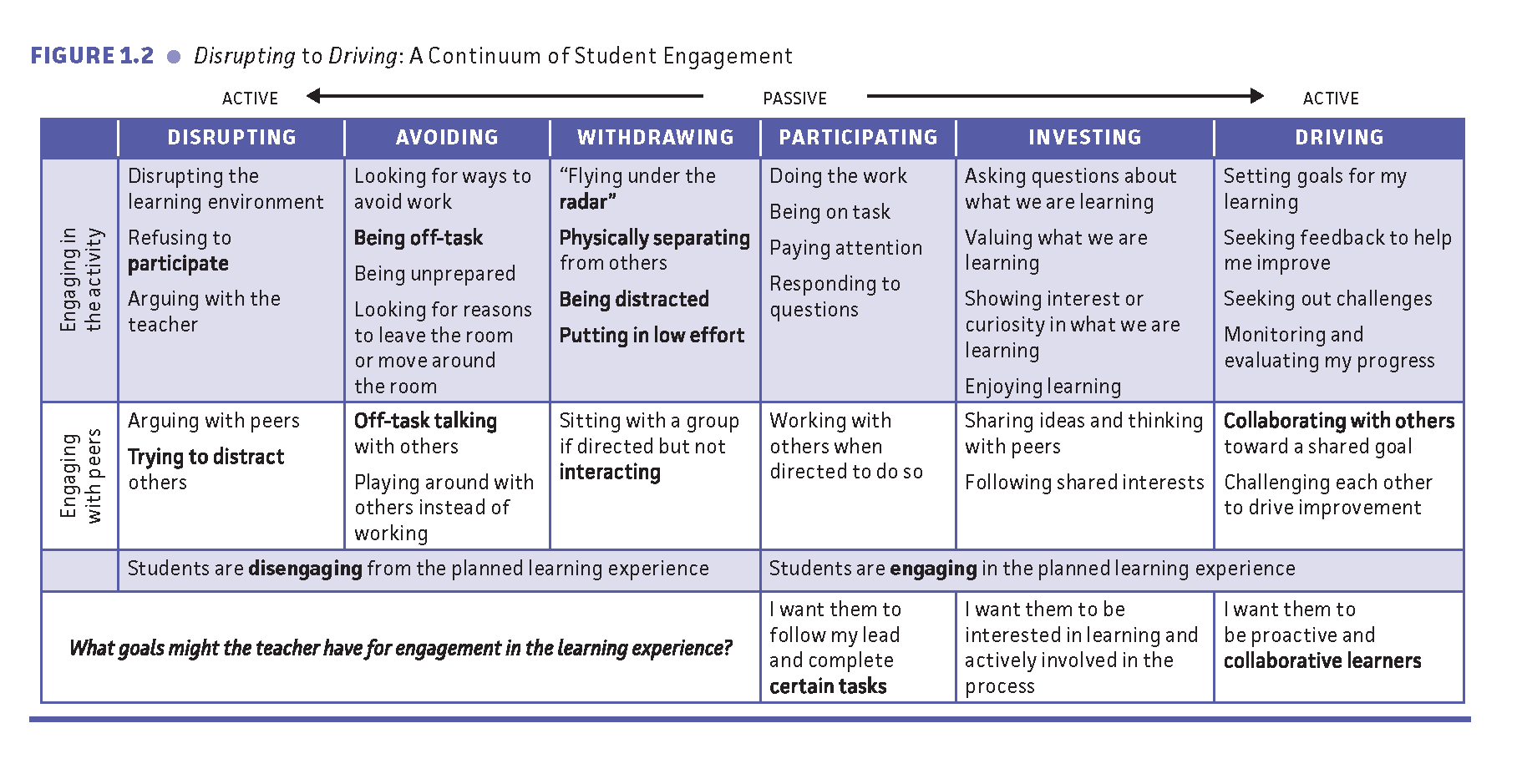While popular understanding of introversion was rising, Vogelsinger was getting a personal education. Because he married an introvert, he began to see the strengths that come from introverts’ propensity for quiet reflection. Just as importantly, he noticed that some of the most powerful writing assignments in his classes came from students who rarely spoke in class. These observations raised questions for how he structured classes in a subject where conversation is king.
“It took me a while to realize that someone can engage rigorously mentally with what’s going on in the classroom, and you might not hear it as a teacher,” Vogelsinger said. “So then how do we make that learning visible? How do we give them chances to share what they’re learning?”
Summer Reading Series: “Quiet” by @SusanCain pic.twitter.com/tZ8TNdLmU3
— Mr. John Curtis (@curtiswords) July 4, 2023
Adding more voices to the conversation with colored index cards
Last spring, Vogelsinger’s English class at Holicong Middle School was discussing whether fate or decision-making played a bigger role in the tragic outcome of Shakespeare’s Romeo and Juliet. Each student had a white index card and a yellow index card on their desk. At the start, he reminded students that a white card “means a fresh new idea no one’s brought up yet,” and a yellow card means you’re building on someone’s line of thinking, “just like yellow snow means someone’s been there before.” He calls this discussion format “white snow/yellow snow.”
As students spoke, classmates raised a white or yellow card to be called on, shuffling between cards after hearing peers’ comments. Vogelsinger devised this strategy to create more on-ramps to class discussions for introverted students, who might take a beat (or several) before volunteering, and by the time they do, their more voluble classmates have gone in a different direction.

About halfway through the Romeo and Juliet discussion, a student named Mary tentatively raised a yellow card about halfway. Another classmate took a turn, and Mary raised her card higher. Vogelsinger nodded to her, giving her the floor, and she softly shared a counterpoint to her classmates’ claims about Romeo’s bad choices.
Vogelsinger said his introverted students usually speak up more when using the index cards. Plus, his extroverted students are reminded to listen and reflect a little more than usual. “Instead of just raising your hand, which you’re doing all day, now you have this other element and you have to think about how [what you want to say] connects to other things with the white snow/yellow snow.”
The index cards also help Vogelsinger monitor the flow of conversation and redirect when things go off track or one idea drags on too long. And they aren’t the only way Vogelsinger invites introverts to participate in class.
Discussion boards and think time
Before classroom discussions start, Vogelsinger also builds in opportunities for students to engage with ideas on their own. Online message boards are one of those opportunities. Though some teachers used online discussion boards before the COVID-19 pandemic, their popularity surged during distance learning. Many teachers heard from new voices through those forums.
“Kids who had been really quiet were responding really well on discussion boards in that last part of the spring from March to June [2020],” Vogelsinger said of his classes. Now he uses message boards as an introvert-friendly form of participation throughout the semester. Sometimes he highlights comments from the boards in class before moving on to another activity. Other times, the message boards lead into a verbal discussion, like the white snow/yellow snow discussion of Romeo and Juliet.
“They’ve already done some thinking about it online. They’ve even interacted with [ChatGPT] and how it wrote about [the play’s themes],” Vogelsinger said. That preparation gives students “roots to the conversation.” Plus, he carved out several minutes before the discussion for students to revisit what they wrote and read each other’s responses. That “think time” is especially helpful for introverted students, who may not want to speak on the spot as soon as a teacher throws out a question.
“Introversion is not about being quiet, shy or reserved,” Vogelsinger said. “It’s about feeling recharged and energized by quiet time, reflective time. … And in English class that’s really valuable. And in learning, that’s really valuable.”
🕒 Wait time 🕒 between asking a question and calling on someone for an answer — as well as waiting to respond to an answer — is an important strategy to include all learners.
Sketchnote via @ValentinaESL pic.twitter.com/I510pm7x5u
— MindShift (@MindShiftKQED) July 23, 2023
Engagement as a continuum
For Vogelsinger, learning about introversion helped him move from deficit thinking to tackling a creative challenge. “I’ve learned not to see an introverted student as someone who’s not engaging as much as I think they should, and rather to see my responsibility as giving a variety of ways to engage,” he said.
He uses the word “engage” intentionally. While “participation” when used in grading usually emphasizes talking in class, engagement encompasses a range of learning behaviors. Education researcher Amy Berry developed a continuum of student engagement that illustrates this concept.

In Berry’s continuum, responding to teacher questions is considered a passive form of engagement, whereas more active engagement includes habits such as asking questions, setting goals, and seeking feedback. These behaviors can occur in both extroverted and introverted ways. What’s essential, according to Berry, is to find out from students themselves what these things look like. “That’s when you’re really going to get somewhere when both teacher and student are able to use the continuum as kind of a foundation and anchor for their conversations about engagement,” she said.
Vogelsinger showed his students the engagement continuum for the first time last year. But he and the other English teachers at Holicong Middle School were asking students what engaged learning looks like well before that. A few years ago, as part of a rethinking process around grades, Vogelsinger and his colleagues created a quarterly self-reflection for students. Students are encouraged to look at patterns in their homework completion, class participation and assignment feedback before responding to several prompts. One of those prompts is:
- Engagement and participation are vital to success, but can look different to different students. Explain how you participate and engage in class.
Questions like that can help teachers see strengths in all students – and spark ideas for how to help them learn. Two decades into his career, it’s not just the idea of an extrovert as the model student that Vogelsinger has shed; it’s the entire concept of a model student.
“Now I think I’m much better at seeing the individual students,” he said. “I’m looking more for growth.”
Taking a shot
On the same day as the white snow/yellow snow discussions of Romeo and Juliet, Vogelsinger took a different approach in one of his classes. For third period, he went with a basketball discussion. To kick things off, students ripped a page out of their notebooks and answered one question: If you could tell one character one thing that might fix this whole play (apart from how it ends), what would it be?
After several minutes of scribbling, Vogelsinger instructed students to crumple their page into a ball. The ideas they’d written would be the launching point for the discussion. The paper balls would be launched into a plastic blue crate at the front of the room.
Students raised their hands to speak, and three times during the period, Vogelsinger paused the conversation. At those moments, everyone who’d spoken up so far could stand and take a shot with their paper ball. By the end, only three class members hadn’t participated. Vogelsinger collected the crumpled papers from those students before they exited.
In the empty classroom, he smoothed the pages, and his eyes tracked over the penciled words. One student wrote: I would tell Romeo that Lady Capulet is sending an assassin after him, because she’s going to send someone with poison to Mantua to kill him.

“That was a great observation. I kind of wish it would have come up in class, but I can still respond to the student now this way,” Vogelsinger said. That’s key. In the basketball discussion, the chance to shoot the ball may motivate kids who like to move, whether introverted or extroverted. But the written responses ensure that Vogelsinger gets a window into the thinking of students who opt out of speaking.




